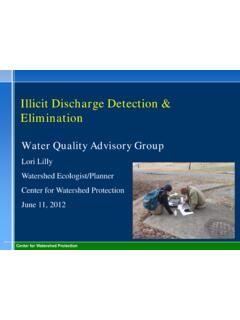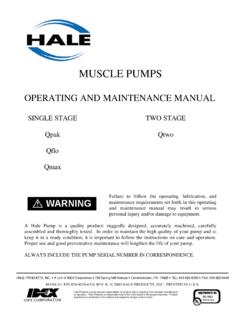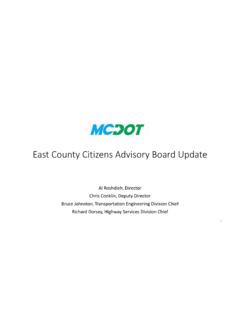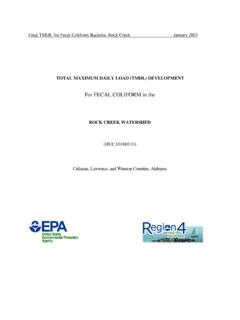Transcription of Rock Creek Watershed Restoration Action Plan
1 Restoration Action Planby theCenter for WatershedProtectionin cooperation withURS CorporationJuly 2001 Prepared forMontgomery County Department ofEnvironmental ProtectionRock Creek WatershedWhat is the Countywide Stream Protection Strategy?The Montgomery County Department of Environmental Protection (MCDEP) developed theCountywide Stream Protection Strategy (CSPS) in 1998. The goal of the CSPS is to preserve, pro-tect, or restore watersheds* by evaluating County stream resource conditions, and identifyingprograms for responding to problems on a subwatershed major impacts to habitat conditions and aquatic life are stream erosion and impacts originate primarily from increased stormwater runoff from developed areas, as well asinadequate sediment control from construction sites and agricultural land.
2 These impacts are relatedto the extent that developed land has replaced natural land cover with impervious areas such asroads, parking lots, driveways, and buildings. This development increases stormwater flows andreduces groundwater infiltration to the detriment of natural stream countywide stream assessment was donebased on evaluation of aquatic life and streamchannel habitat indicators in addition totypically applied stream chemistry measure-ments from over 200 monitoring all Montgomery County streams meetMaryland water quality standards and criteriafor dissolved oxygen, temperature, and.
3 The extent and diversity of biologi-cal life and stream habitat conditions 129 8 Good 680 46 Fair 391 26 Poor 143 9 DataCollected,UnderAnalysis171 11 TOTAL 1514 100 For more information about the Countywide Stream Protection Strategy contact Keith Van Ness, Senior Water QualitySpecialist at 240-777-7726 or go to the CSPS website at County s Water Quality Goals- Protect, maintain, and restore high quality chemical, physical, biological, and stream habitatconditions in County streams that support aquatic life and uses such as recreation and water supply- Restore County streams damaged by inadequate stormwater management practices of the past byre-establishing the flow regime, chemistry, physical conditions and biological diversity of naturalstream systems as closely as possible through improved stormwater management practices- Work with other jurisdictions to restore and maintain the integrity of the Anacostia River, thePotomac River, the Patuxent River.
4 And the Chesapeake Bay- Promote and support educational and volunteer initiatives that enhance public awareness andincrease direct participation in stream stewardship and the reduction of water pollutionMontgomery County has a rich and diverse natural heritage, which includes over 1,500 miles ofstreams that provide habitat vital to aquatic life. To preserve this natural heritage, the County hasadopted a Countywide Stream Protection Strategy with the following water quality goals:2 Rock Creek Watershed Restoration Action plan * Words in bold typeface are defined at the end of this publication in the glossaryRock Creek WatershedRock Creek begins as a small spring emerging from a spring house in the Laytonsville area, andflows approximately 21 miles before entering the District of Columbia.
5 Distinct geographic charac-teristics along the Route 28 corridor divide the Rock Creek Watershed , and form the upper and lowerwatersheds of Rock Creek . This urban Watershed is highly developed and densely populated in thelower portion, while the upper portion is moderately developed, with some remaining agriculturaland open areas. The Upper Rock Creek Watershed contains many miles of small headwater streamsunlike Lower Rock Creek , where prior development piped many headwater areas, impacting aquatichabitat and stream systems. The high level of development and lack of stormwater controls have ledto unmitigated flows that have damaged Rock Creek and its Creek Watershed MapTypical stream section in Upper Rock Creek water-shedA stream valley park system exists along themain stem that connects to Rock CreekNational Park in , and provides recre-ational opportunities as well as a protectivebuffer along the mainstem and tributaries ofRock Creek .
6 These parks create safe overflowareas for typical flooding events, preservevernal pools and wetlands within the flood-plain, and offer opportunites to establishrestorative or control measures,which will also enhance the parksrecreational stream section in the Donnybrook Tributarylocated in the Lower Rock Creek watershedLakes Needwood and Frank, located within the UpperRock Creek Watershed , were originally constructed inthe 1960 s for flood control and recreation. Theselakes provide significant water quantity control andwater quality benefits such as sediment Creek Watershed Restoration Action Plan3 Lowe r RockCreek StreamResourceConditionsStreamMilesPe rce ntStreamMilesEx Collected,Under r R ockCreek StreamResourceConditionsStreamMilesPe rce ntStreamMile sEx Collected,Under Creek is the second largest Watershed in Montgomery County with a drainage area of approxi-mately 60 square miles.
7 Rock Creek and its tributaries flow into the Potomac River, and eventuallyto the Chesapeake Bay, which is one of the region s most important resources. The CSPS rankedstream conditions in Rock Creek as highly variable, ranging from excellent to poor. These resultsare shown in the tables below for upper and lower portions of the Watershed and in the map below bysubwatershed. Restoring Rock Creek will not only improve water quality, biological communitiesand stream conditions, but will also increase the aesthetic and recreational value for many peoplewho utilize the Rock Creek Watershed for active and passive Restore Rock Creek ?
8 Rock Creek Subwatershed Stream Conditions4 Rock Creek Watershed Restoration Action PlanThis 4-part study used field data and hydrologic models to: evaluate subwatershed stream conditions,identify the best sites for stormwater management and stream Restoration projects, evaluate LakesNeedwood and Frank, and perform a final Watershed Rock Creek Watershed Feasibility Study was undertaken to identify the most severe problemlocations and assess opportunities for habitat and aquatic life Restoration . This study provides thetechnical information necessary to develop this Rock Creek Watershed Restoration Action plan thataddresses the effects of uncontrolled stormwater or inadequate control of runoff from the Creek Watershed Feasibility StudyWatershed Impacts and ProblemsThrough the CSPS and field analyses, MCDEP revealed that the primary problems in the RockCreek Watershed are:- Uncontrolled runoff from high stormwater flowsdue to large areas of imperviousness or hard sur-faces (parking lots, roads, rooftops, etc.)
9 Uncon-trolled runoff has several impacts, including: Severe erosion contributing to unstable streambanks,increased sediment loads, and impaired instreamhabitat Undermining of stormdrain and utility infrastructure Nonpoint source pollution (discharges of fertilizers,household products, etc.)- Fish passage problems for resident and anadro-mous fish species (permanent and partial barriers)- Periodic spills, illegal discharges of pollutants,and leaky sewer infrastructureBank erosion in Lower Coquelin RunTrash and debris in Lower Donnybrook tributarydeposited by high stormflowsRock Creek Watershed Restoration Action plan 5 Outfall in Lower Turkey Branchcausing bank erosion andexposed tree roots (left)Fish barrier prevents upstreammigration in Rock Creek (right)
10 The Rock Creek Watershed Feasibility Study identified, prioritized and designed stormwater man-agement and stream Restoration projects in support of the County s Watershed Restoration proposed stormwater management facilities should improve water quality conditions anddecrease erosive velocities, while the stream Restoration projects will provide erosion protection andultimately improve habitat conditions. Together, these projects should reduce sediment loads in thestreams of Rock Creek Management Projects in Rock CreekForty-eight potential stormwater management project sites were field investigated, and a technicalscoring system was used to identify the top 20 sites in the Watershed .








![Chapter 11. Consumer Protection. [Note]](/cache/preview/0/e/f/f/d/d/6/c/thumb-0effdd6ceb968c7fc46f30d60315699f.jpg)










